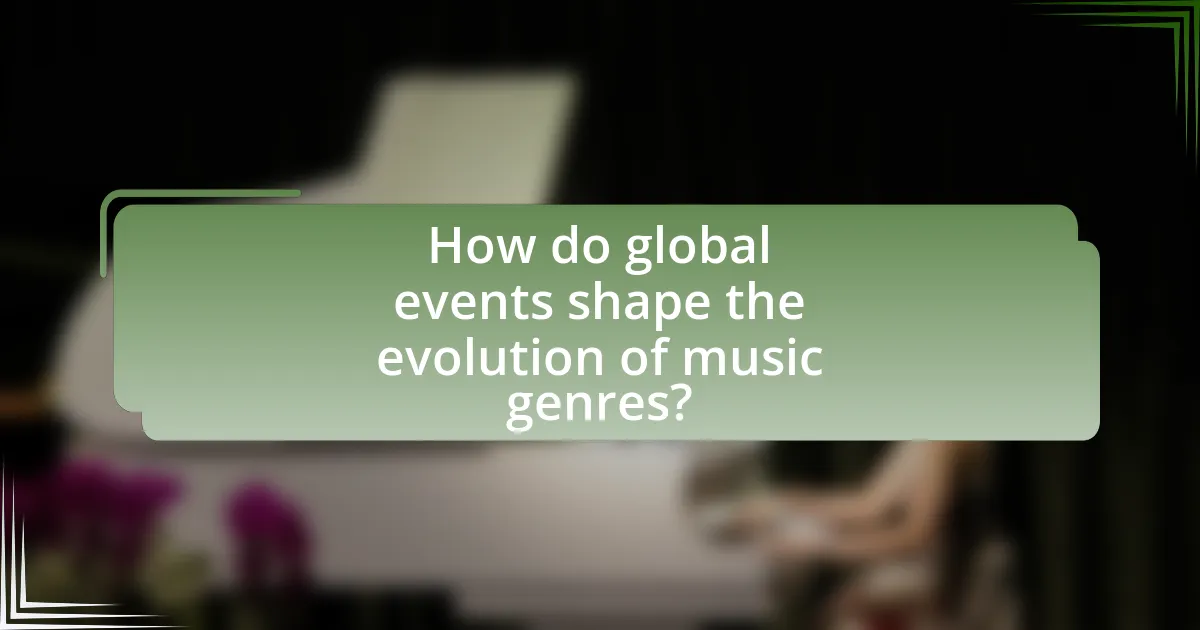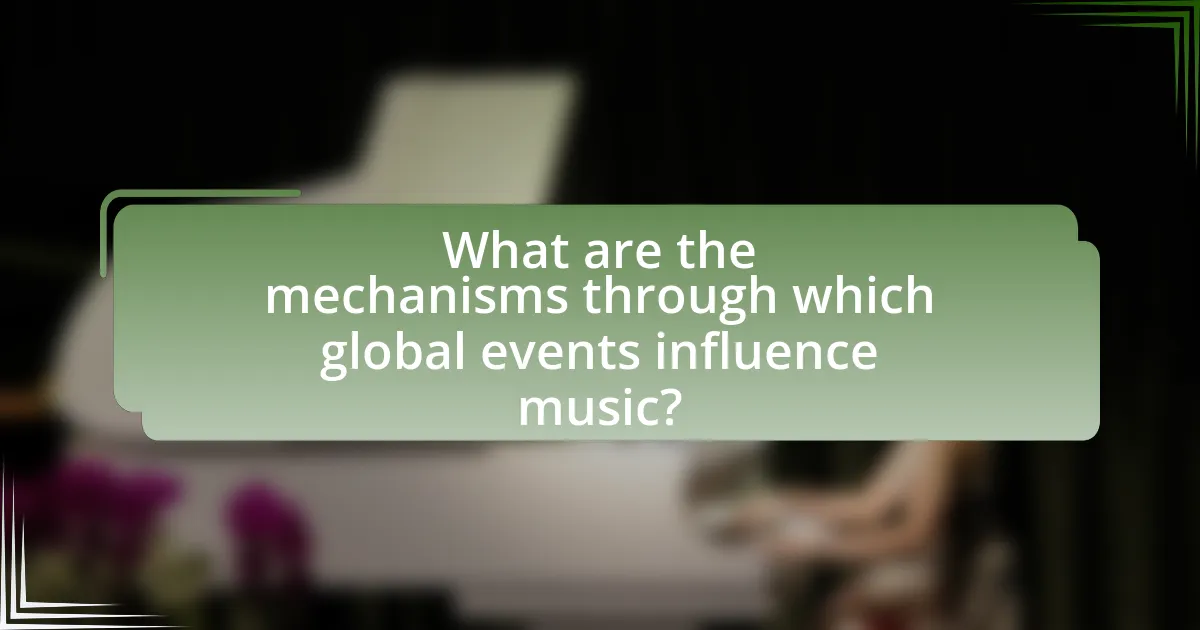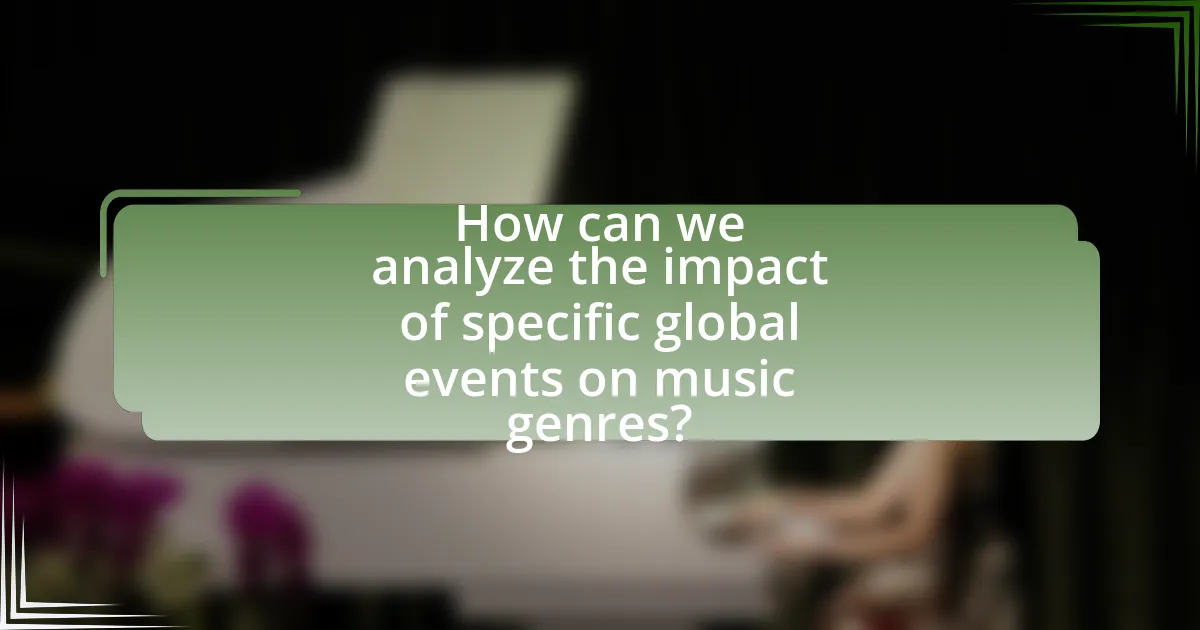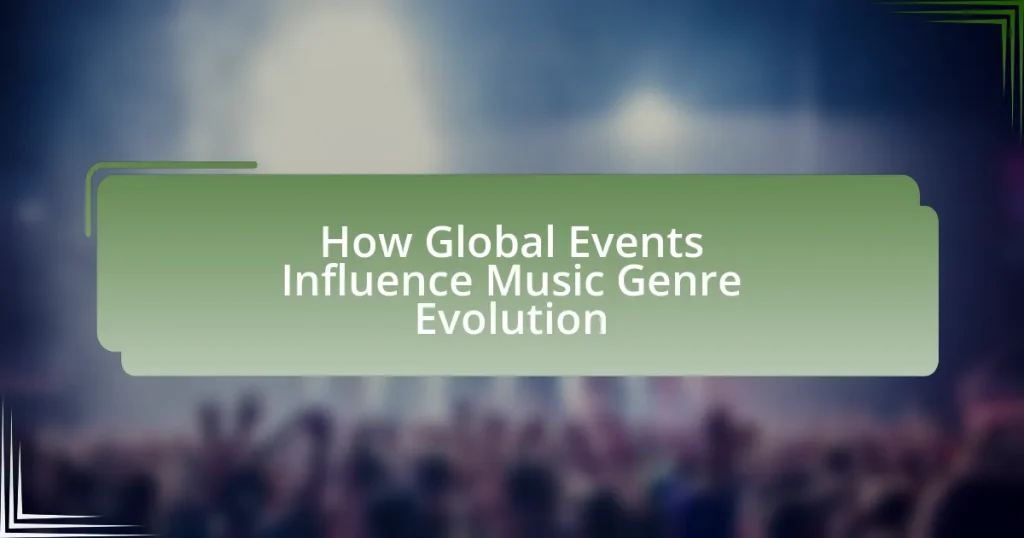The article examines how global events influence the evolution of music genres, highlighting the impact of cultural exchanges, social movements, and technological advancements. It discusses historical examples such as the civil rights movement’s effect on soul and funk, the emergence of protest music during the Vietnam War, and the role of the internet in facilitating genre blending. Additionally, the article explores the mechanisms through which wars and cultural movements shape musical trends, emphasizing the importance of studying these relationships to understand societal values and emotional landscapes reflected in music. Through case studies and analysis, it illustrates the dynamic interplay between global events and musical expression.

How do global events shape the evolution of music genres?
Global events significantly shape the evolution of music genres by influencing cultural exchanges, social movements, and technological advancements. For instance, the civil rights movement in the United States during the 1960s led to the rise of genres like soul and funk, which incorporated themes of social justice and empowerment. Similarly, the global spread of reggae music in the 1970s was propelled by political unrest in Jamaica and the diaspora’s experiences, which resonated with audiences worldwide. Additionally, technological advancements such as the internet have facilitated the rapid dissemination of diverse musical styles, allowing genres to blend and evolve more quickly than ever before. These examples illustrate how global events act as catalysts for musical innovation and transformation.
What types of global events have historically influenced music genres?
Global events such as wars, social movements, technological advancements, and cultural exchanges have historically influenced music genres. For instance, World War II led to the rise of jazz and blues as forms of expression for the African American community, reflecting their struggles and experiences during that time. The civil rights movement in the 1960s significantly impacted genres like folk and rock, with artists like Bob Dylan and Joan Baez using their music to advocate for social change. Additionally, the advent of the internet has transformed music distribution and consumption, giving rise to genres like electronic dance music, which thrives on global connectivity and collaboration. These examples illustrate how significant global events shape the evolution of music genres by influencing themes, styles, and the way music is created and shared.
How do wars impact the development of music styles?
Wars significantly influence the development of music styles by introducing new themes, instruments, and cultural exchanges. For instance, World War I and II led to the emergence of genres like jazz and blues, which incorporated elements of African American experiences during the conflicts. The Vietnam War catalyzed the rise of protest music, with artists like Bob Dylan and Joan Baez using their platforms to address social issues, reflecting the sentiments of the era. Additionally, wars often result in the migration of people, which facilitates the blending of musical traditions, as seen with the integration of Middle Eastern sounds into Western music post-9/11. These historical contexts demonstrate how wars serve as catalysts for musical innovation and evolution, shaping the cultural landscape.
In what ways do cultural movements affect musical trends?
Cultural movements significantly influence musical trends by shaping the themes, styles, and messages within music. For instance, the civil rights movement in the 1960s led to the emergence of genres like soul and funk, which expressed the struggles and aspirations of African Americans. This is evidenced by artists such as James Brown and Aretha Franklin, whose music became anthems for social change. Additionally, the punk movement in the 1970s introduced a raw, rebellious sound that reflected disillusionment with mainstream society, as seen in bands like The Ramones and Sex Pistols. These examples illustrate how cultural movements not only inspire new musical forms but also alter the societal context in which music is created and consumed.
Why is it important to study the relationship between global events and music?
Studying the relationship between global events and music is important because it reveals how societal changes and historical contexts shape musical expression and genre evolution. For instance, the emergence of protest songs during the Civil Rights Movement in the United States illustrates how music can reflect and influence social change, with artists like Bob Dylan and Nina Simone using their platforms to address issues of racial injustice. Additionally, the impact of World War II on jazz music, which saw the genre evolve as soldiers returned home and cultural exchanges occurred, demonstrates how global events can lead to significant shifts in musical styles and themes. Understanding this relationship allows researchers and enthusiasts to appreciate music not just as art, but as a historical document that captures the zeitgeist of its time.
What insights can we gain about society through music evolution?
Music evolution provides insights into societal values, cultural shifts, and historical contexts. For instance, the emergence of jazz in the early 20th century reflected the African American experience and the struggle for civil rights, showcasing how music can embody social change. Similarly, the rise of punk rock in the 1970s was a response to political disillusionment and economic hardship, illustrating music’s role as a form of protest. Furthermore, the popularity of hip-hop since the 1980s highlights issues of race, identity, and urban life, revealing how music serves as a voice for marginalized communities. These examples demonstrate that music evolution is closely intertwined with societal dynamics, acting as both a mirror and a catalyst for change.
How does music reflect the emotional landscape of its time?
Music reflects the emotional landscape of its time by serving as a cultural response to societal events, collective feelings, and prevailing ideologies. For instance, during the Great Depression, folk music emerged as a voice for the struggles of the working class, with artists like Woody Guthrie expressing themes of hardship and resilience. Similarly, the civil rights movement of the 1960s saw the rise of protest songs, such as “A Change Is Gonna Come” by Sam Cooke, which encapsulated the hopes and frustrations of the era. These examples illustrate how music not only mirrors the emotional state of society but also acts as a catalyst for social change, reinforcing the connection between global events and musical evolution.

What are the mechanisms through which global events influence music?
Global events influence music through cultural exchange, social movements, and technological advancements. Cultural exchange occurs when artists from different backgrounds collaborate or share influences, leading to the fusion of musical styles, as seen in the global popularity of reggae and hip-hop. Social movements, such as civil rights or anti-war protests, inspire musicians to create songs that reflect societal issues, exemplified by Bob Dylan’s “The Times They Are a-Changin'” during the 1960s. Technological advancements, like the internet and social media, facilitate the rapid dissemination of music across borders, allowing genres to evolve and adapt quickly, as evidenced by the rise of K-pop on global platforms. These mechanisms demonstrate how interconnectedness and societal changes shape the music landscape.
How do technological advancements play a role in music genre evolution?
Technological advancements significantly influence music genre evolution by enabling new sounds, production techniques, and distribution methods. For instance, the introduction of synthesizers in the 1960s and 1970s led to the emergence of electronic music genres like synth-pop and techno, which transformed the musical landscape. Additionally, the advent of digital audio workstations (DAWs) in the 1990s allowed artists to produce music more easily and experiment with diverse styles, resulting in genres such as lo-fi and trap. Furthermore, streaming platforms have changed how music is consumed, allowing for a wider variety of genres to gain popularity globally, as seen with the rise of K-pop and reggaeton in the 2010s. These advancements demonstrate that technology not only shapes the sound of music but also influences its accessibility and cultural reach.
What impact does the internet have on music distribution and genre blending?
The internet significantly transforms music distribution and genre blending by enabling instant access to a global audience and facilitating cross-genre collaborations. Digital platforms like Spotify and SoundCloud allow artists to distribute their music widely without traditional gatekeepers, leading to increased visibility for diverse genres. For instance, the rise of platforms has contributed to the popularity of genres like lo-fi hip-hop and reggaeton, which blend elements from various musical traditions. According to a 2021 report by the International Federation of the Phonographic Industry, streaming accounted for 62% of global recorded music revenue, underscoring the internet’s role in reshaping how music is consumed and shared. This accessibility encourages artists to experiment with different styles, resulting in innovative genre fusions that reflect a more interconnected musical landscape.
How do recording technologies shape musical styles?
Recording technologies significantly shape musical styles by influencing how music is produced, distributed, and consumed. For instance, the advent of multi-track recording in the 1960s allowed artists to layer sounds and experiment with complex arrangements, leading to the development of genres like progressive rock. Additionally, the introduction of digital recording in the 1980s democratized music production, enabling independent artists to create and share their work without major label support, which contributed to the rise of genres such as electronic and indie music. Historical evidence shows that the transition from analog to digital formats not only changed the sound quality but also altered the creative processes of musicians, as seen in the shift from traditional studio recordings to home-based production setups.
What role do social movements play in the evolution of music genres?
Social movements significantly influence the evolution of music genres by shaping cultural narratives and providing a platform for expression. For instance, the civil rights movement in the United States led to the rise of genres like soul and funk, which incorporated themes of resistance and empowerment, as seen in the works of artists like James Brown and Aretha Franklin. Similarly, the anti-war movement during the Vietnam War era gave birth to protest music, with folk and rock artists like Bob Dylan and Joan Baez using their music to voice dissent and inspire activism. These movements not only inspire lyrical content but also affect musical styles, instrumentation, and performance practices, reflecting the socio-political climate of their times.
How do protests and activism influence musical expression?
Protests and activism significantly influence musical expression by inspiring artists to create songs that reflect social and political issues. For instance, during the Civil Rights Movement in the 1960s, musicians like Bob Dylan and Nina Simone produced powerful anthems that addressed racial injustice and inequality, such as “The Times They Are a-Changin'” and “Mississippi Goddam.” These songs not only resonated with the struggles of the time but also galvanized public sentiment and mobilized listeners toward activism. Additionally, contemporary movements like Black Lives Matter have led to a resurgence of protest music, with artists such as Kendrick Lamar and Janelle Monáe using their platforms to address systemic racism and police brutality, further demonstrating how activism shapes the themes and messages in music.
What examples exist of music genres emerging from social change?
Examples of music genres emerging from social change include hip-hop, which developed in the 1970s in response to urban poverty and social inequality in the Bronx, New York. This genre reflects the struggles and experiences of marginalized communities, often addressing issues such as racism, violence, and economic hardship. Another example is punk rock, which emerged in the 1970s as a reaction to political disillusionment and social unrest, particularly in the UK and the US, expressing anti-establishment sentiments and a desire for change. Additionally, reggae music arose in Jamaica during the 1960s, influenced by the Rastafarian movement and addressing themes of social justice, resistance, and the struggles against colonialism. These genres illustrate how music can serve as a powerful voice for social change and reflect the cultural and political climates of their times.

How can we analyze the impact of specific global events on music genres?
To analyze the impact of specific global events on music genres, researchers can examine historical data, lyrical content, and shifts in musical styles that correlate with significant occurrences. For instance, the emergence of punk rock in the 1970s can be linked to political unrest and economic challenges, reflecting societal sentiments. Additionally, studies like “Music and Social Movements: Mobilizing Traditions in the Twentieth Century” by Ron Eyerman and Andrew Jamison illustrate how music serves as a response to social change, providing concrete examples of genres evolving in reaction to events such as civil rights movements or wars. By utilizing qualitative and quantitative methods, including surveys and music analysis, scholars can effectively map the relationship between global events and the evolution of music genres.
What case studies illustrate the influence of global events on music?
Case studies illustrating the influence of global events on music include the impact of World War II on jazz and the emergence of protest music during the Civil Rights Movement in the United States. During World War II, jazz evolved as a form of expression and escapism, with artists like Duke Ellington and Louis Armstrong gaining prominence, reflecting the cultural shifts and the need for morale-boosting entertainment. Similarly, the Civil Rights Movement saw artists such as Bob Dylan and Nina Simone use their music to address social injustices, with songs like “The Times They Are a-Changin'” and “Mississippi Goddam” becoming anthems for change, showcasing how music can respond to and shape societal movements. These examples demonstrate the direct correlation between significant global events and the evolution of music genres.
How did the Civil Rights Movement shape genres like soul and jazz?
The Civil Rights Movement significantly shaped genres like soul and jazz by infusing them with themes of social justice, empowerment, and resistance. Artists such as Nina Simone and Sam Cooke used their music to address racial inequality and inspire activism, exemplified by songs like “Mississippi Goddam” and “A Change Is Gonna Come,” which became anthems of the movement. The movement’s emphasis on African American identity and pride also led to a richer, more expressive musical style, as musicians sought to reflect their experiences and struggles. This period saw jazz evolve into more politically charged forms, such as free jazz, with artists like John Coltrane and Ornette Coleman pushing boundaries to convey the urgency of the civil rights struggle. The intersection of music and activism during this era solidified the role of soul and jazz as powerful vehicles for cultural expression and social change.
What effects did the COVID-19 pandemic have on music production and consumption?
The COVID-19 pandemic significantly disrupted music production and consumption by forcing artists and producers to adapt to remote collaboration and digital platforms. With live performances canceled, musicians increasingly turned to online streaming services and social media to reach audiences, leading to a surge in virtual concerts and live-streamed events. According to a report by the International Federation of the Phonographic Industry (IFPI), global music streaming grew by 19.9% in 2020, highlighting a shift in consumer behavior towards digital consumption. Additionally, the pandemic prompted a rise in home recording and production, as artists sought to create music independently, resulting in a diversification of genres and styles. This shift has fundamentally altered the landscape of the music industry, emphasizing the importance of digital engagement and innovative production methods.
What tools and methods can be used to study music genre evolution?
To study music genre evolution, researchers utilize tools such as data analysis software, music information retrieval systems, and machine learning algorithms. These tools enable the analysis of large datasets, including audio features, lyrics, and historical trends. Methods like qualitative analysis of cultural context, quantitative statistical analysis of genre characteristics, and network analysis of artist collaborations further enhance understanding. For instance, studies have shown that machine learning can classify genres based on audio features with high accuracy, demonstrating its effectiveness in genre evolution research.
How can music analytics help us understand genre changes over time?
Music analytics can help us understand genre changes over time by analyzing patterns in song characteristics, listener preferences, and cultural influences. By examining data such as tempo, key, instrumentation, and lyrical themes, researchers can identify shifts in musical styles that correlate with historical events, technological advancements, or social movements. For instance, studies have shown that the rise of hip-hop in the 1980s coincided with urbanization and socio-political changes in the United States, as reflected in the lyrical content and production techniques of the genre. Additionally, streaming data reveals how listener demographics and geographic trends influence genre popularity, providing insights into the evolution of music in response to global events.
What role does ethnomusicology play in analyzing music’s response to global events?
Ethnomusicology plays a crucial role in analyzing music’s response to global events by examining the cultural, social, and political contexts that shape musical expressions. This field of study investigates how music reflects and influences societal changes during significant global occurrences, such as wars, migrations, and social movements. For instance, ethnomusicologists have documented how protest songs emerged during the Civil Rights Movement in the United States, illustrating music’s function as a tool for social change and collective identity. By employing qualitative research methods, including fieldwork and interviews, ethnomusicologists provide insights into how communities use music to process and respond to global events, thereby reinforcing the connection between music and cultural resilience.
What practical steps can musicians take to adapt to global influences?
Musicians can adapt to global influences by incorporating diverse musical styles and collaborating with artists from different cultures. This approach allows musicians to blend genres, creating innovative sounds that resonate with a wider audience. For instance, the rise of Afrobeat in Western music showcases how artists like Beyoncé and Drake have successfully integrated African rhythms and instrumentation into their work, reflecting a growing global interconnectedness in music. Additionally, utilizing digital platforms for distribution and promotion enables musicians to reach international audiences, further enhancing their adaptability to global trends.
How can artists incorporate global events into their music effectively?
Artists can effectively incorporate global events into their music by using relevant themes, narratives, and sounds that resonate with the audience’s experiences. For instance, during significant events like the COVID-19 pandemic, artists such as Taylor Swift and Billie Eilish released songs that reflected feelings of isolation and uncertainty, capturing the emotional landscape of their listeners. This approach not only creates a connection with the audience but also contextualizes the music within the current socio-political climate, making it more impactful. Additionally, artists can utilize samples, news clips, or direct references to events in their lyrics, as seen in songs like “This Is America” by Childish Gambino, which addresses gun violence and systemic racism, thereby enhancing the relevance and urgency of their message.
What strategies can musicians use to stay relevant in a changing musical landscape?
Musicians can stay relevant in a changing musical landscape by embracing digital platforms, collaborating across genres, and engaging with their audience through social media. Digital platforms like Spotify and YouTube allow musicians to reach wider audiences and adapt to changing consumption habits, as evidenced by the fact that over 60% of music listeners now use streaming services. Collaborating with artists from different genres can introduce new sounds and attract diverse fan bases, which has been shown to increase streaming numbers and concert attendance. Additionally, active engagement on social media helps musicians build a loyal community, as studies indicate that artists who interact with fans online see a 30% increase in fan retention.




